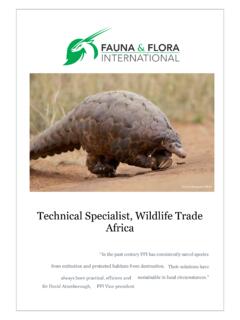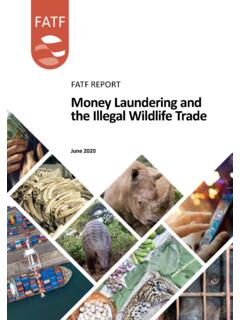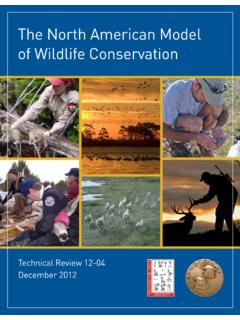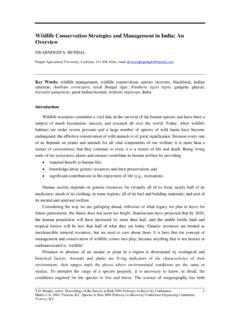Transcription of A guide to using the CITES Trade Database
1 A guide to using the CITES Trade Database Version 8 October 2013 UNITED NATIONS ENVIRONMENT PROGRAMME WORLD CONSERVATION MONITORING CENTRE Contents 1. INTRODUCTION .. 3 THE CITES Trade Database .. 3 ANNUAL REPORTING REQUIREMENTS OF CITES PARTIES .. 3 ANNUAL REPORT COMPILATION 4 ANNUAL REPORT SUBMISSION 4 WHY ANALYSE CITES Trade DATA? .. 4 STATUS AND ACCURACY OF CITES ANNUAL REPORT DATA .. 5 REFERENCING THE CITES Trade STATISTICS .. 6 2. USE OF THE Database .. 6 SELECTION OF DATA VARIABLES .. 6 SELECTION OF REPORT TYPE .. 6 3. INTERPRETATION OF DATA OUTPUTS .. 6 COMPARATIVE TABULATION REPORTS .. 6 GROSS/NET Trade REPORTS .. 9 ANNEX 1. TERM AND UNIT CODES .. 11 ANNEX 2. PURPOSE AND SOURCE CODES .. 12 ANNEX 3. COUNTRY AND TERRITORY CODES .. 14 ANNEX 4. CHRONOLOGICAL LIST OF CITES PARTIES .. 17 ANNEX 5.
2 ALPHABETICAL LIST OF CITES PARTIES .. 19 ANNEX 6. CONTACT DETAILS .. 21 Important note: It must be stressed that the outputs produced by the CITES Trade Database can be easily misinterpreted if one is not familiar with them. We therefore strongly recommend you read this guide before starting to use the Database . 1. Introduction The following explanatory notes have been prepared as an aid to understanding the CITES Trade Database and its constituent data. This first section serves as an introduction to the Database , providing some background to the reporting process that gives rise to the data, and highlighting some of the limitations of the data. The following section explains how to use the online Database in practice, with guidance on the various options available to the user.
3 Finally, the third section explains how to interpret the two types of output produced by the Database : comparative tabulations and gross/net Trade tabulations. The CITES Trade Database The CITES Trade Database , managed by the UNEP World Conservation Monitoring Centre (UNEP-WCMC) on behalf of the CITES Secretariat, is unique and currently holds over 13 million records of Trade in wildlife and over 34,000 scientific names of taxa listed in the CITES Appendices. Around a million records of Trade in CITES -listed species of wildlife are currently reported annually and these data are entered into the CITES Trade Database (an Oracle relational Database ) as soon as they are received by UNEP-WCMC. CITES annual reports are the only available means of monitoring the implementation of the Convention and the level of international Trade in specimens of species included in the CITES Appendices.
4 The CITES Trade Database can be queried and data downloaded from the CITES website ( ) or the UNEP-WCMC website ( ). You can contact UNEP-WCMC directly (see Annex 6 for contact details) if you have a specific data request that you are unable to answer using the online data querying facilities. Important note: The CITES Secretariat has created on its website a forum for users of the CITES Trade Database . Any user is welcome to join this forum to exchange comments or queries on this tool. You may register on this page: Annual reporting requirements of CITES Parties CITES provides a legal framework for regulating international Trade in species threatened or potentially threatened by that Trade . It is based on a system whereby permits or certificates are issued for international Trade in specimens of species listed in one of three Appendices, each of which provides a different degree of Trade control.
5 There are currently 178 Parties to CITES , States that have joined the Convention. Each one must designate a 'Management Authority' that is responsible for issuing permits and compiling annual reports on their international Trade in specimens of CITES -listed species. This is a requirement under Article VIII, paragraph 7 (a), of the Convention. Under the provisions of Resolution Conf. (Rev. CoP16), annual reports may be sent either to the offices of the Secretariat in Switzerland or directly to UNEP-WCMC (in which case CITES Trade Database User guide , version 8 3 a note should be sent to the CITES Secretariat informing them that this has happened). UNEP-WCMC has been the Secretariat's consultant for the management of computerized CITES Trade statistics since 1980.
6 Annual reports are submitted in various formats: copies of permits, printed reports and electronic. The annual report data are entered into the CITES Trade Database and outputs are generated to allow global statistics to be derived for analysis. Note: Not all countries are Parties to CITES (see Annexes 4 and 5 for a list of Parties). However, it is possible to determine some levels of Trade involving non-Parties from the records of Parties that Trade with them. Annual report compilation Parties are requested to compile their reports in accordance with the Guidelines for the preparation and submission of CITES annual reports circulated with CITES Notification to the Parties No. 2011/019 of 17 February 2011. Common departures from these guidelines are as follows: Many annual reports do not clearly state whether the data were derived from the actual number of specimens traded or from the quantity for which the permits or certificates were issued (often considerably different); Information on seized or confiscated specimens is often absent or provided in insufficient detail; Information on the source of the material, wild-caught or bred in captivity, and the purpose of the Trade , for commercial or non-commercial purposes, is sometimes lacking or used in a different way by importing and exporting countries; and Non-standard units are often used to describe the volume of articles or commodities in Trade , 'boxes'.
7 Annual report submission Under the terms of CITES Resolution Conf. (Rev. CoP16), Parties are required to submit annual reports to the CITES Secretariat by 31 October of the year following the one in which the Trade occurred. If the data are submitted in the form of permits, it is advisable that Parties submit these to UNEP-WCMC well before that date, as these records have to be entered into the Database manually. Not all Parties submit their annual reports on time, some are incomplete, and some Parties do not submit any annual report for several years because of internal problems, such as civil war, lack of personnel or resources, etc. In special circumstances, a Party may request, and the Secretariat may grant, an extension to the 31 October deadline. As a result of these reporting problems, the most recent year for which comprehensive Trade statistics are available is normally two years before the current year.
8 A table of annual report submissions since 2006 can be found at: Why analyse CITES Trade data? The objectives of many analyses of CITES Trade data are as follows: To monitor Trade levels and identify where Trade might adversely affect wild populations; CITES Trade Database User guide , version 8 4 To assess whether the information supplied by each Party provides an accurate representation of its Trade in CITES -listed species and whether the data were provided in sufficient detail to fulfil the requirements of CITES ; To ascertain whether the available data provide evidence of Trade infractions or inadequate enforcement of CITES and national regulations; To discern the most important Trade in terms of volume; To provide a summary of major Trade between countries and thus facilitate, over time, the analysis of trends in Trade .
9 To identify major anomalies in the reporting of imports and exports. Status and accuracy of CITES annual report data The data entered into the UNEP-WCMC CITES Trade Database undergo a four-stage checking process: 1) Visual checks of each annual report are made to attempt to identify any obvious problems, such as use of common names for species instead of scientific names, cities indicated as destinations instead of countries, etc.; 2) Several of the data input fields have mandatory values against which the data are compared; 3) Records are checked for correct species distribution and valid combinations of taxon and term, taxon and source, etc. (it should be noted that this checking process has only been functioning since November 1995); and 4) A further visual check is made of all Database outputs.
10 Where concerns arise over the clarity or accuracy of the data submitted, these are normally communicated directly to the relevant Management Authorities. It is recommended that Parties base their annual reports on permits that have been used. However, some Parties base their reports simply on the permits or certificates they have issued. It is not uncommon for the quantity of specimens traded to be considerably less than the amount specified on the permits, or for permits not to be used at all. Thus Trade transactions that may never have taken place and inaccurately reported volumes of Trade , will exist in the CITES Trade data. Details on the method of reporting used for reports received are available from UNEP-WCMC on request (see Annex 6 for contact details). CITES Notification to the Parties No.







